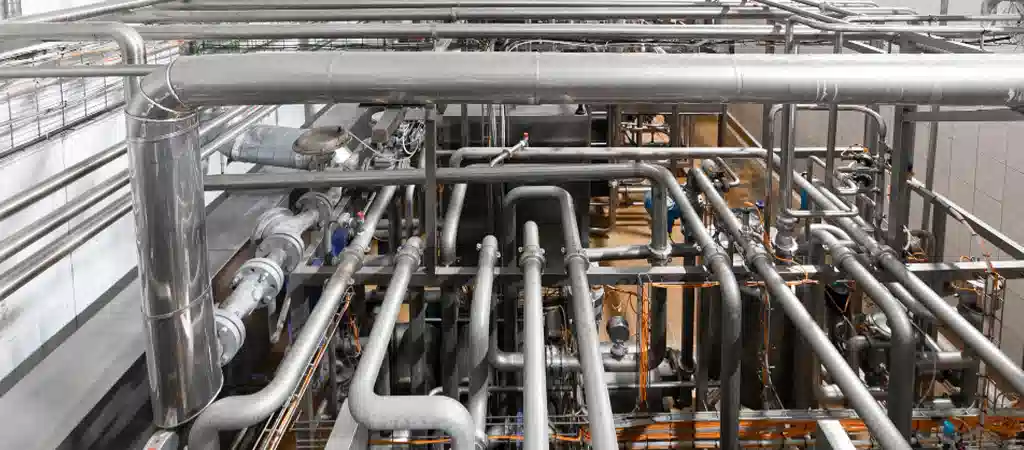Piping: Definition and Introduction

Piping is a fundamental term in engineering and industrial processes, describing a system used to transport fluids (liquids or gases) through a network of pipes. This important element has applications in a variety of fields, from household plumbing to complex industrial operations like Refinery, Petrochemical, Pharma and Food processing industries.
Understanding the Basics of Piping
If we talk about its core components, piping involves the use of pipes, tubes, valves, and fittings to facilitate the transfer of liquids or gases. The materials used in these pipes can vary, including metals such as steel, copper and stainless steel, as well as plastics and composite materials, each selected based on the application and the fluid being transported.
Piping in everyday life
In our daily life, we mainly encounter piping in plumbing systems. These systems ensure the delivery of clean water to all buildings including homes, offices and commercial establishments, thereby promoting cleanliness and convenience. It is equally important to remove waste water, maintain a hygienic environment effectively.
Heating, ventilation and air conditioning (HVAC) systems also rely on piping to circulate hot or cold water, creating a comfortable indoor environment in all seasons. Additionally, natural gas pipelines safely transport gas to our kitchens, heating systems and appliances, making our lives more comfortable and efficient.
Industrial Applications of Piping
Piping is increasingly gaining in importance in industrial settings. For example, oil and gas refineries rely on complex piping networks to transport crude oil, natural gas and processed products between various units and storage facilities, facilitating the production and distribution of essential fuels and petrochemicals.
Chemical processing plants also use advanced piping systems to manage the movement of chemicals during production. Furthermore, power plants harness the power of steam by transporting it through well-designed piping systems, converting it into electricity to light up our lives.
Piping is important because it helps transport liquids and gases around the world. It is used in our homes, businesses, and industries. New technologies are being developed to make piping even more efficient and safe.
Here are some specific examples of how piping is used in our everyday lives:
- It brings clean water to our homes and businesses.
- It carries away wastewater and sewage.
- It delivers natural gas to our homes for heating and cooking.
- It transports oil and gasoline to our cars and trucks.
- It carries chemicals and other industrial materials to factories and businesses.
Piping is also used in many other ways that we may not even think about, such as:
- Cooling systems in buildings
- Irrigation systems for agriculture
- Pipeline transportation of oil and gas
- Telecommunications cables
Design and Safety Considerations
Designing a proper piping system requires expert engineering and careful planning. Engineers take into account factors such as fluid properties, flow rate, pressure, temperature and facility layout to ensure efficient operation and safety. Modern computer-aided design (CAD) tools aid in the modeling and optimization of piping systems, ensuring they meet performance and safety standards.
Safety is paramount in piping systems. Careful material selection, accurate installation, and regular inspection and maintenance are essential to the integrity and reliability of the infrastructure, in order to avoid any mishaps.
Piping Codes and Standards
To maintain consistency and safety in piping design, construction and operation, international and national codes and standards have been established. These guidelines serve as a reliable reference for engineers, contractors and operators, ensuring adherence to best practices, safety protocols and quality assurance.
Conclusion
As technology advances, new materials and methods are being developed to make piping even more efficient and safe. For example, new plastics are being used to make pipes that are lighter, stronger, and more resistant to corrosion. New welding techniques are being developed to make pipes that are more leak-proof. And new sensors are being developed to monitor the condition of pipes and alert us to potential problems.
The future of piping is bright. As technology continues to advance, piping will become even more essential to our modern world. It will help us to transport resources more efficiently and safely, and it will help us to protect our environment.
Read Also
Download Free Piping PDF for Interview Preparation
What is gasket and their types
What is a valve and its types?
How to download pdf
Check bottom of post downloadable link is available…for some posts still we are creating pdf so sorry for inconvenience but but most of the pdf is already uploaded please check carefully.
Thanks for your comments brother
Keep visiting and share with your friends
Sir,
The information which you shared is very useful ,but I need pdf copy .I am getting only piping pdf, I need same for gaskets,valves,static equipment and rotary equipment as well.